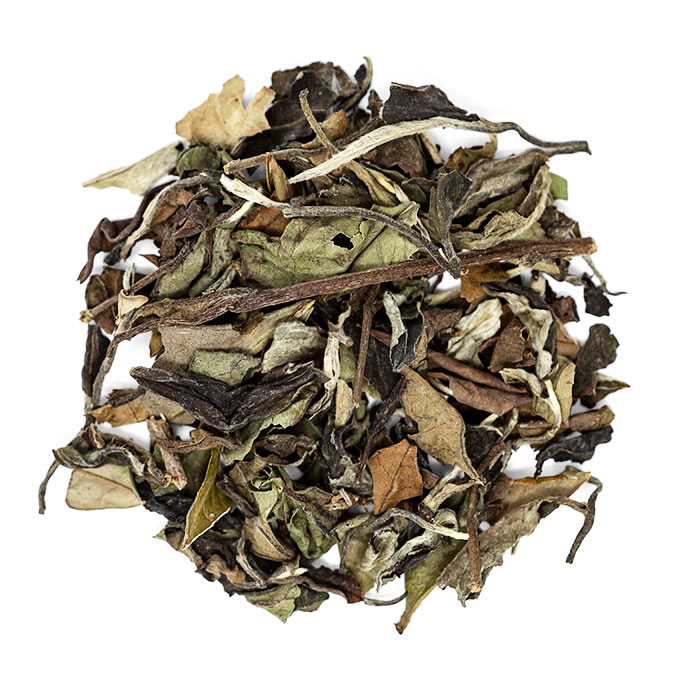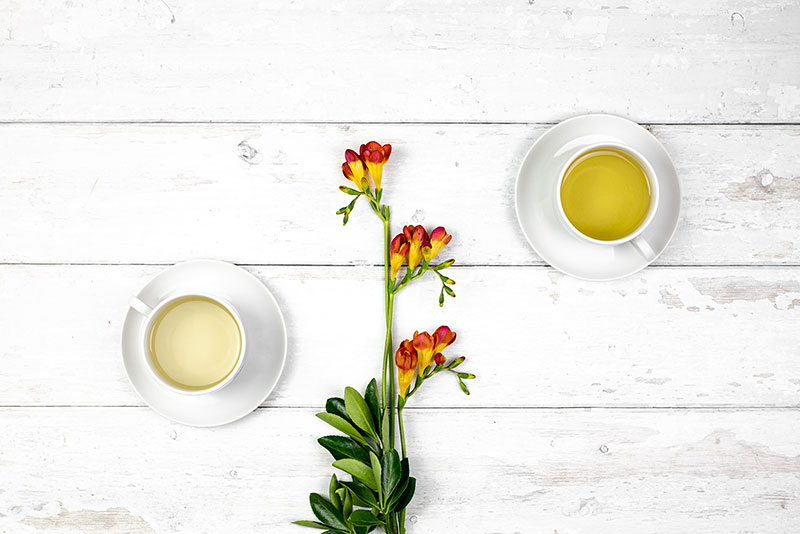White Tea vs Green Tea Differences
Both healthy, both light, both rich in antioxidants–white and green tea are both similar and very different. White tea and green tea are two distinct tea types made from the same plant–Camellia sinensis. They can both have a high level of caffeine, antioxidants and a delicious flavor. While green tea is popular world-wide, white tea is reserved mostly for those who want to enjoy the highest health benefits and a delicate flavor. But which one is better?
What is the difference in processing white and green tea?
Both white and green tea are less processed than black, dark or oolong tea. White tea is minimally processed. When brewed correctly, it often has a very light, almost transparent liquor. Hence the name–white. Green tea goes through more processing. For making white tea, tea leaves are withered outdoors right after harvesting. Then they go through an indoor drying and sorting. Green tea is first withered, then goes through a process of stopping the oxidation, rolling, drying and sorting. Some green teas are not withered, but all white teas are.
Because of the way it’s processed, high quality white tea–especially Silver Needle–will have a lot of hairy buds. And this is an interesting part. Although the processing of white tea looks very easy, it’s not easy at all. You are more likely to stumble upon a low quality white tea than a low quality green tea. This may be a reason white tea doesn’t enjoy so much popularity as the green tea does.
Besides, white tea is not as widely available as green tea, and not all tea producing countries are making it. While there are thousands of different green teas in the world, you could easily count all the widely available white teas. Next, white tea should never be packed into tea bags. If it is, it’s likely it doesn’t contain any buds at all, and is made mostly by tea dust from older mature tea leaves.
White tea vs green tea growing areas and seasons
White tea is mostly grown in China, especially in the Fujian province. Some exceptional white teas come from India and Sri Lanka too. Green tea is grown in almost every tea growing country. White tea is usually harvested in spring and early summer. Green tea can be harvested in autumn too. The highest quality Silver Needle and the first flush green teas are plucked during the days of early spring. Other white teas are harvested later, around May.
Does white tea have more caffeine than green tea?
Although many considered white tea to be a low caffeine drink, that’s not always true. In fact, white tea can have more caffeine than green tea. In fact, it can sometimes have more caffeine than black tea. How is this possible? Because all real teas are made from the “same “plant–Camellia sinensis. The amount of caffeine depends on many factors, for example:
- Tea varietal and cultivar
- Growing conditions
- The time of harvesting and the method of harvesting
- Processing methods
- The way you brew it
It’s impossible to say how much caffeine will your cup of tea have. However, you can guess the amount by judging the leaves. For example, teas that contain younger leaves will have more caffeine than those with older and bigger mature leaves. Teas harvested in spring and summer are likely to have more caffeine than autumn teas. If you use broken leaves or tea dust, your cup will probably have a higher caffeine content too.
Studies have shown that Silver Needle and White Peony Chinese white teas may have more caffeine than many Chinese green teas. Japanese shaded green teas such as Gyokuro are likely to have more caffeine than white tea, and many other green teas. One Polish study showed that the average amount of caffeine for white teas is 28.584 mg per 100 ml and 26.445mg for green tea per 100 ml. Tea in the study was made with 1 gram of leaves steeped for 5 minutes at 212°F[1].
Keep in mind though, even if you are using more tea leaves per cup of water, you should not use boiling water for white or green tea. That’s why the total amount of caffeine will be lower in the tea you make at home than it was in the this study.
Both white and green tea contain much less caffeine compared to other caffeinated beverages. For example, a cup of coffee contains, on average, 100 mg of caffeine. But that amount can be much lower or much higher too. The biggest cups of regular coffee in coffee shops may have more than 300 mg of caffeine per serving.
Difference in taste
Both white tea and green tea can offer a whole range of flavors–from fresh and vegetal, to nutty and sweet, even bitter.
Most common white tea flavors: hay, fresh, lightly sweet, spicy
Most common green tea flavors: vegetal, fresh, lightly sweet, smokey, nutty, toasty
Green tea is likely to have a stronger flavor than white tea, but not always. For example, Silver Needle white tea is one of the lightest teas in the world and rarely any other tea can beat its lightness. On the other hand, Dragon Well green tea is also light, but has a much more flavor and sweetness. Pai Mu Tan white tea is stronger, often with fresh hay notes and yellowish color, but never as strong as the strong green tea – for example Gunpowder.
Is white tea healthier than green tea?
Both white and green teas contain high amounts of antioxidants. They are both made from the same plant and share most of the health benefits. White tea is usually described as a “beauty tea “, while the green tea has a title of a “weight-loss tea “. In fact, both may be good for skin, provide antioxidant boost and help with weight loss goals. However, neither of them will help much unless you include exercise and a healthy diet into your lifestyle. Both pure white and pure green tea have almost zero calories. If you are drinking tea to enjoy health benefits, avoid adding sugar, honey or milk.
Catechins in white and green tea
White and green tea have antimutagenic properties, anti inflammatory properties, anti-aging properties, may help in protecting the teeth, reducing the risk of heart disease and aid in weight loss. How much you can benefit from a cup of tea will depend on many tea compounds. For example, catechins are responsible for many benefits–from fighting free radicals to promoting the cardiovascular health and helping with fat burn. One study showed that the amount of total catechins in white tea ranges from 14.40 to 369.60 mg per gram of dry leaf, and 21.38 to 228.20 mg per gram of green tea dry leaf[2].
Therefore, it’s impossible to say which is healthier. Catechin poor white tea may have less potential to provide benefits than the catechin poor green tea. On the other hand, green tea that contains the most catechins may still have much less catechins than the catechin rich white tea.
However, the most expensive high quality tea doesn’t always need to have the most catechins. One study showed that between the three types of white tea–Silver Needle, White Peony and Shou Mei, White Peony had almost three times more EGCG than Silver Needle when brewed at 212°F. But at the lower temperature of 176°F, the difference was minimal.

Pai Mu Tan or White Peony white tea
White tea vs green tea brewing
You can brew both white and green tea using western or eastern brewing technique. Western brewing technique implies using a simple teapot, strainer or infuser and steeping the leaves in hot water (but not boiling) for 2-3 minutes. Usually, one teaspoon will be enough for one cup of water. The best water temperature for both white and green tea is 167°F-185°F.
Eastern brewing technique means using smaller teapot, a higher amount of leaves, a bit hotter water, shorter steeping times and re-steeping the leaves multiple times. For white tea, you can use very hot water (194°F) and steep the leaves for 20-30 seconds. For green tea, 194°F are likely to ruin the leaves, even if you are steeping them less than usually. The best steeping time for the first infusion is 45-60 seconds. As every tea is different, it’s impossible to generalise. Try experimenting to get the best flavor.
Unlike some green teas, white tea is not suitable for making tea lattes. You can use both white and green teas for making iced tea or for cold brewing.
So, which is better white tea or green tea?
It’s impossible to say which tea is better. Try both types of tea and experiment with brewing. Both of them may have a positive effect on health and offer real drinking enjoyment.
Disclaimer: This article is for informational purposes only. It’s not intended to replace medical advice, diagnosis or treatment. Every person is different and may react to different herbs and teas differently. Never use teas or herbs to treat serious medical conditions on your own. Always seek professional medical advice before choosing home remedies.
References:
[1] https://www.researchgate.net/publication/319682455_Study_of_nutritional_value_of_dried_tea_leaves_and_infusions_of_black_green_and_white_teas_from_Chinese_plantations




